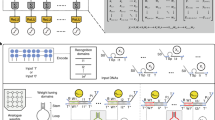Abstract
Adleman showed that hybridization of pairs of complementary DNA strands could be used for molecular computation. We have explored the possibility that a neural network in which the usual axons and neurons are replaced by the diffusion and molecular recognition of DNA is a possible route to fault-tolerant molecular computation. In this paper we review our model for a DNA analog neural network, estimate the ultimate speed of DNA computations, present an enzymatic representation of DNA matrix algebra and show some exploratory experimental results. We discuss the basis for our optimism on the prospects for practical DNA computing.
Similar content being viewed by others
Author information
Authors and Affiliations
Rights and permissions
About this article
Cite this article
Mills Jr., A., Turberfield, M., Turberfield, A. et al. Experimental aspects of DNA neural network computation. Soft Computing 5, 10–18 (2001). https://doi.org/10.1007/s005000000061
Issue Date:
DOI: https://doi.org/10.1007/s005000000061




